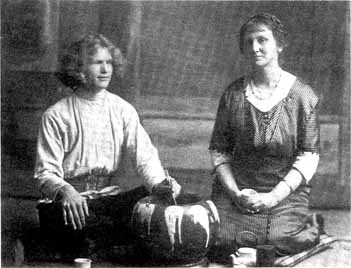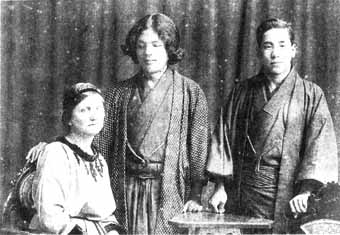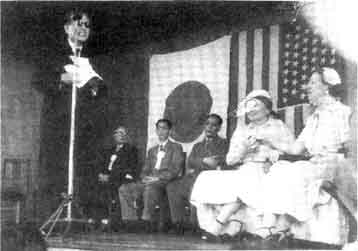
|
Abstract:
Extensive history of Bahá'í events and personages in Japan, 1914-1983.
Notes:
See also Errata for Traces that Remain and Japan Will Turn Ablaze.
Proofread by S. Sims and updated August 2019.
|
Chapter 21
 click here for larger image Miss Alexander and Vasily Eroshenko, a blind Russian Esperantist, who lived for a time in Tokyo. He did the first translation of the "Hidden Words of Bahá'u'lláh" (Arabic section), into Esperanto in 1916. He helped Miss Alexander learn both English and Esperanto Braille, and he introduced her to many people, including Mr. Torii. Mr. Eroshenko was greatly attracted to the Faith at the time. Later he left Japan and returned to Russia, and, according to Miss Alexander, he lost the inspiration he had received through the Bahá'í Teachings. This photograph was taken in 1915.
Mr. Torii, Mr. Kenjiro Ono and Mr. Tomonaga Noto all wrote to 'Abdu'l-Bahá. The blind were shown great love by Him. Five of His eighteen Tablets to Japanese were addressed to the blind; two to Mr. Torii, two to Mr. Ono and one to Mr. Noto. Miss Alexander continued to have many opportunities through the years to meet the blind and attend their meetings.
 Miss Alexander and Mr. Kenjiro Ono. He was the first blind man to study in a university in Japan (1914). He was greatly attracted to the Faith, and he helped Miss Mochizuki start the first Bahá'í magazine in Japanese, "Higashi no Hoshi," but he did not commit himself to the Faith.
This photograph was dated March 31, 1915. Miss Alexander is sitting at the far right, and Mr. Eroshenko next to her. It is apparently an Esperanto group.
 click here for larger image Mr. Torii is speaking before the Blind Association, on the occasion of Miss Keller's visit to Japan. She is sitting second from the right. Miss Keller was well aware of the Faith and wrote appreciatively of it.
|
| METADATA | |
| Views | 277860 views since posted 2000; last edit 2025-01-28 14:57 UTC; previous at archive.org.../sims_traces_that_remain; URLs changed in 2010, see archive.org.../bahai-library.org |
| Language | English |
| Permission | author |
| History | Scanned 2000 by Jonah Winters; Formatted 2000 by Jonah Winters; Proofread 2000 by Barbara R. Sims. |
| Share | Shortlink: bahai-library.com/414 Citation: ris/414 |
|
|
|
|
Home
search Author Adv. search Links |
|